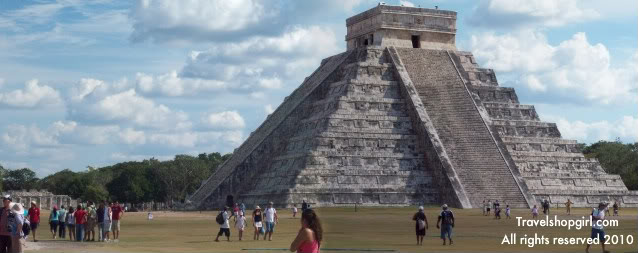 A Western Caribbean cruise can stop at what may be considered an unfamiliar ports to some such as Progreso, (Yucatan) Mexico or Calica, Mexico as well as Cozumel. What can you do in these ports? Although I am sure no one wants to turn down a beach day, I highly recommend a visit to Chichen Itza, one of the Seven Wonders of the World.
A Western Caribbean cruise can stop at what may be considered an unfamiliar ports to some such as Progreso, (Yucatan) Mexico or Calica, Mexico as well as Cozumel. What can you do in these ports? Although I am sure no one wants to turn down a beach day, I highly recommend a visit to Chichen Itza, one of the Seven Wonders of the World.
Chichen Itza, which means “at the mouth of the well of the Itza,” is a large pre-Columbian archaeological site built by the Maya civilization located in the northern center of the Yucatán Peninsula, in the Yucatán state, present-day Mexico. Chichen Itza was a major focal point in the northern Maya lowlands from the Late Classic through the Terminal Classic and into the early portion of the Early Postclassic period. The site exhibits a multitude of architectural styles, from what is called “Mexicanized” and reminiscent of styles seen in central Mexico to the Puuc style found among the Puuc Maya of the northern lowlands. The presence of central Mexican styles was once thought to have been representative of direct migration or even conquest from central Mexico, but most contemporary interpretations view the presence of these non-Maya styles more as the result of cultural diffusion. The ruins of Chichen Itza are federal property, and the site’s stewardship is maintained by Mexico’s Instituto Nacional de Antropología e Historia (National Institute of Anthropology and History, INAH). The land under the monuments had been privately-owned until March 29, 2010, when it was purchased by the state of Yucatan.
One of the most photographed area of Chichen Itza is El Castillo (the castle) in the Great North Platform. This step pyramid has a ground plan of square terraces with stairways up each of the four sides to the temple on top. On the Spring and Autumn equinox, at the rising and setting of the sun, the corner of the structure casts a shadow in the shape of a plumed serpent – Kukulcan, or Quetzalcoatl – along the west side of the north staircase. On these two annual occasions, the shadows from the corner tiers slither down the northern side of the pyramid with the sun’s movement to the serpent’s head at the base. In the 1980s, Chichen Itza began to receive an influx of visitors on the day of the spring equinox. Today several thousand show up to see the light-and-shadow effect on the Temple of Kukulcan in which the feathered serpent god supposedly can be seen to crawl down the side of the pyramid. Over the past several years, INAH, which manages the site, has been closing monuments to public access. While visitors can walk around them, they can no longer climb them or go inside their chambers. The most recent was El Castillo, which was closed after a San Diego, Calif., woman fell to her death in 2006. It is still a spectacular site that you can only appreciate in person as the pictures simply do not do it any justice.
After visiting Chichen Itza, you can cross this one off the list and then you’ll only have six more to visit!
- The Great Wall, China
- Petra, Jordan
- Christ Redeemer, Brazil
- Machu Picchu, Peru
- The Roman Collesseum, Italy
- The Taj Mahal, India




